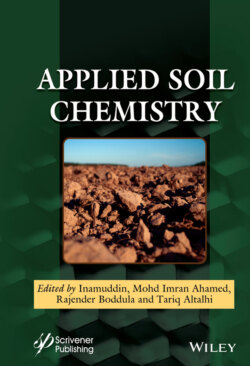Читать книгу Applied Soil Chemistry - Группа авторов - Страница 52
2.3.2.4 Biotic Processes Factor
ОглавлениеBiotic processes in case of chemical weathering can be discussed in two sections. One is organic residue effects and other is ionic uptake cycles. Plants which are very tall physically affects chemical weathering by increasing the size of the cracks in rocks, as a result of which movement of water is easier and also it shades the soil, thereby affecting evaporation and soil temperature. High plants as well as microorganisms fasten the nutrients release from minerals through exchange of hydrogen ions with minerals charge and absorption. According to Bastisse and Demolon et al. in the year 1946 [1], it was reported that plants were one of responsible factors of weathering owing to the fact that soil planted with trees released higher quantity of potassium in comparison to unplanted soil. Jackson and Hseung et al., in the year 1952 [87], reported that soil acidity accumulation is followed by micas depotassication. As per Kellog et al., in the year 1943 [16], it was reported that in case of bare soil or virgin soil due to vegetation nutrients are returned as organic residue to the soil surface. Organic matter accumulation on the surface of the soil has considerable impact on the minerals weathering, either by distribution of aluminium oxide and iron present in soil or by bases leaching. As per Kanehiro and Sherman et al. in the year 1948 [99–101], it was reported that ferns present in regions of tropical humid Hawaii, below highly acidic forest floor have reactions in the pH range between 3 and 4,which is relative to the white pine forest floor the zone of cool temperate region. The organic matter mixed with soil controls the rate of chemical weathering and loss of bases. The rate of chemical weathering is faster in case of highly acidic forest floor in comparison to alkaline or neutral forest floor. Some kinds of organic matter, specifically organic acids, give rise to formation of complex with sesquioxide ions and transfer them to subsoil from the upper horizon and little amount inside the ground water. Elimination of iron out of ferromagnesian minerals is increased owing to this activity. The overall process of weathering as reported by Jackson and Hseung in the year 1952 [16] was influenced because of elimination of iron oxides from horizon A and accumulation in horizon B. As per Vagelor et al., in the year 1933 [102–104], and Mohr et al., in the year 1944 [96], it was reported that in tropical areas vegetal canopy is highly significant. According to Mohr et al., in the year 1944, it was reported that air temperature above the soil is considerably less in case of canopy forest. Similarly, soil enveloped by forest has 10°C to 15°C. The decrease in the temperature makes all the chemical reaction slower. Organic matter decomposition is slower, causing deposition of organic substances either in or at horizon surface. The condition in deciduous tropical forest and evergreen tropical forest is considerably different. Gupta and Griffith et al., in the year 1947 [105], reported that when teak is planted in laterite soil then a crust of laterite is formed due to the soil dehydration during the dormant leafless stage or drought period. The laterite soil formed hampers the tree growth. Sherman et al., in the year 1953 [106], verified these findings in case of Hawaiian Islands.
